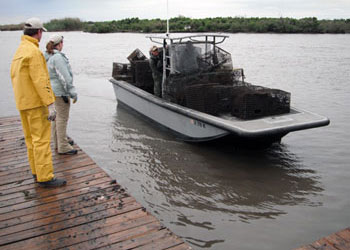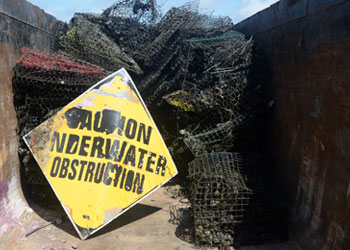Derelict Crab Trap Rodeos
Info | Volunteers | FAQs | Promotional Materials | Prevention & Education | Past Rodeos | Photos | Contact
Derelict Crab Trap FAQs
 What is a derelict trap?
What is a derelict trap?
A derelict crab trap is defined as any trap that is not being actively fished and tended and may range from a crushed and barnacle-encrusted old trap without a line and buoy to a fairly new trap with a line and buoy.
Where do they come from?
All water-based user groups contribute to derelict crab traps. Derelict traps may originate from: accidental loss of actively fished traps due to tides, currents or storm surges; weathering of buoys or lines; clipping of buoy lines by vessel propellers; displacement of traps caught in shrimp gear; intentional cutting of buoy lines by vandals; abandonment of fishable traps by fishermen who leave the fishery; and improper disposal of old, unfishable traps.
Are all derelict crab traps illegal?
No. Only derelict traps that are intentionally discarded or abandoned by crab trap fishermen are illegal.

What is the issue?
Derelict crab traps continue to catch blue crabs and other marine animals, many of which eventually die. Derelict traps may also result in user group conflicts with other individuals who share waterways for other types of fishing and recreation. Additionally, derelict traps pose navigational hazards to boaters and are unsightly.
Can derelict traps be picked up anytime?
No! Only shrimp fishermen who catch unserviceable crab traps in their gear or owners of the trap may remove derelict traps.
What is the solution?
The Louisiana Department of Wildlife and Fisheries derelict crab trap removal program is a positive solution to derelict traps.
